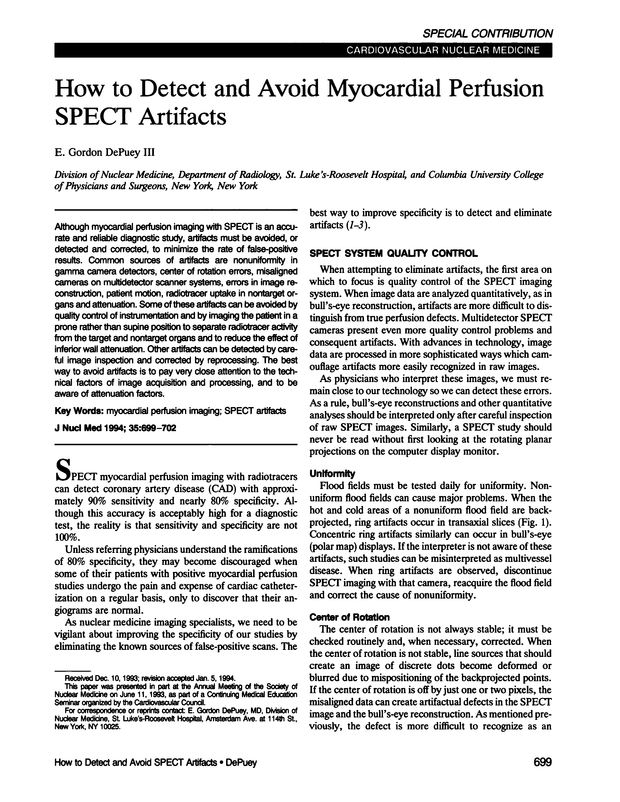Research ArticleSpecial Contribution
How to Detect and Avoid Myocardial Perfusion SPECT Artifacts
E. Gordon DePuey
Journal of Nuclear Medicine April 1994, 35 (4) 699-702;


This is a PDF-only article. The first page of the PDF of this article appears above.
In this issue
Jump to section
Related Articles
- No related articles found.
Cited By...
- Vasodilator Stress Perfusion CMR Imaging Is Feasible and Prognostic in Obese Patients
- An Investigation of a Sinogram Discontinuity Artifact on Myocardial Perfusion Imaging
- Motion-Frozen Myocardial Perfusion SPECT Improves Detection of Coronary Artery Disease in Obese Patients
- A Physiologic Approach to Decreasing Upward Creep of the Heart During Myocardial Perfusion Imaging
- Combined Supine and Prone Quantitative Myocardial Perfusion SPECT: Method Development and Clinical Validation in Patients with No Known Coronary Artery Disease
- Prone Versus Supine Patient Positioning During Gated 99mTc-Sestamibi SPECT: Effect on Left Ventricular Volumes, Ejection Fraction, and Heart Rate
- Prognostic Implications of Combined Prone and Supine Acquisitions in Patients with Equivocal or Abnormal Supine Myocardial Perfusion SPECT
- Effect of Acquisition Orbit on SPECT in Phantoms
- Poststress Motionlike Artifacts Caused by the Use of a Dual-Head Gamma Camera for 201Tl Myocardial SPECT
- Brain SPECT Artifacts in Patients Having Metallic Cranioplasty
- Clinical Impact of Combination of Scatter, Attenuation Correction, and Depth-Dependent Resolution Recovery for 201Tl Studies
- Technical Aspects of Myocardial SPECT Imaging
- American College of Cardiology/American Heart Association Clinical Competence Statement on Stress Testing : A Report of the American College of Cardiology/American Heart Association/American College of Physicians-American Society of Internal Medicine Task Force on Clinical Competence
- American College of Cardiology/American Heart Association clinical competence statement on stress testing: A report of the American College of Cardiology/American Heart Association/American College of Physicians-American Society of Internal Medicine Task Force on Clinical Competence
- Multicenter Clinical Trial to Evaluate the Efficacy of Correction for Photon Attenuation and Scatter in SPECT Myocardial Perfusion Imaging





